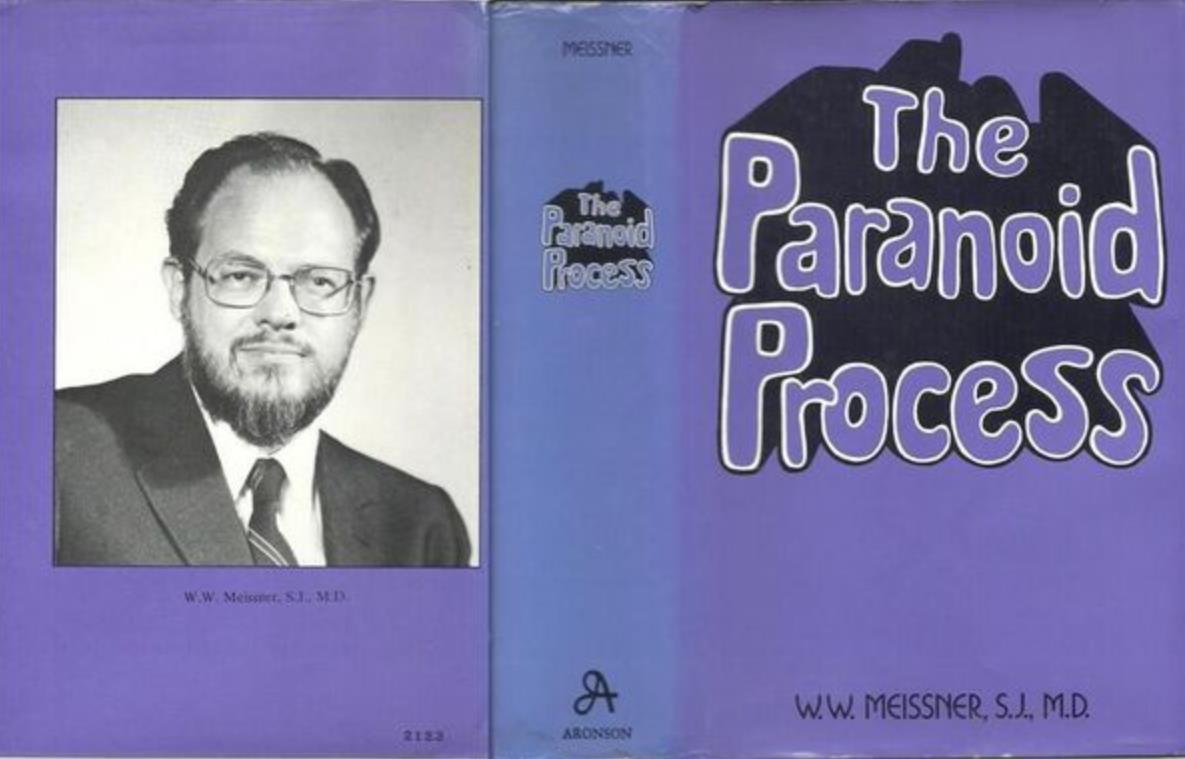按照《精神分析诊断》一书作者南希威廉姆斯的说法,关于偏执最全面的书当属《偏执过程》。
在生活中我们遇到一些容易愤怒、容易情绪激动,激动了可能大声吼叫,也会不太信任他人的人,可能就是神经症性的偏执人格。还有很多社交恐惧的人群,也是偏执的原因所致。
这些人其实很常见,而且我们也知道,除此之外他们也拥有很多优点,也会带给我们很多快乐。比如偏执的人做事认真,非常专注,很单纯,热爱生活等。
人无完人,每种人格都有自己的优缺点,也有它存在的意义。所以,在不够了解他们的情况下,不要偏见的看待“偏执”一词,也不要被它所吓倒。
在有足够的了解的情况下,才会避免因无知而产生的恐惧和偏见。并能够给予有效的帮助。
我会持续来翻译和注解本书内容
Chapter 1 The Development of Theoretical Perspectives
第1章 理论方面的发展
The concept of paranoia was bequeathed to modern psychiatry in its Kraepelinian form. Kraepelin tried to distinguish paranoia from paraphrenia and paranoid dementia praecox. He described it as an insidiously developing, relatively unchanging delusional system which involved no hallucinations and could exist side by side with clear and orderly thinking. One of the basic problems in dealing with paranoia is that it usually is compounded with schizophrenic manifestations. Freud himself recognized this and still felt that there were grounds for distinguishing paranoia on dynamic bases. The specificity that he wished to retain seemed to have been based on the specific psychodynamic ideology that he defined in the now famous Schreber case. Sullivan on the other hand imagined them as imaginary poles of a clinical continuum. The imaginary poles stood apart and were rarely, if ever, in fact realized. He felt that every schizophrenic has some paranoid feelings and can be led to express them from time to time, and that conversely, every paranoid person also has some period of schizophrenic adjustment in his history(Sullivan,1956).
偏执症的概念以克雷佩林(Kraepelin)[德国精神病专家,与弗洛伊德同年生]的形式传给了现代精神病学。克雷佩林试图将偏执症与妄想痴呆和偏执型早发性痴呆区分开来。他将其描述为一种不知不觉中发展起来的、相对不变的妄想系统,它不涉及幻觉,可以与清晰有序的思维并存。处理偏执症的一个基本问题是,它通常与精神分裂症的表现相混合。弗洛伊德自己也意识到了这一点,并且仍然认为在动力学的基础上区分偏执症是有道理的。他希望保留的特性似乎是基于他在如今著名的史瑞伯案例中定义的特定的精神动力观念。另一方面,沙利文把它们想象成一个临床连续统的假想极点。想象中的两极是分开的,很少能真正实现。他认为每个精神分裂症患者都有一些偏执的感觉,并且可以被引导着不时地表达出来,相反,每个偏执的人在他的历史上也有一段精神分裂症的调适期。
(Sullivan,1956)。The trend, however, has been in the direction of using the concept of paranoia with greater flexibility and with greater applicability. It is used not only as a diagnostic category but also as a descriptive personality trait which is characterized by isolation, hypersensitivity, guardedness, suspiciousness, and the use of projection as a defense. It has also been extended to include concepts of paranoid traits, or a paranoid attitude or outlook (Schwartz,1963). In the present review we will be using the concept "paranoia" in its broader meaning as applying both to paranoid traits, paranoid mechanisms, or paranoid styles of life that can apply with varying degrees of intensity and pathology from severely disturbed psychotic states to relatively innocuous and more or less adaptive life-styles in relatively normal individuals and cultural institutions.
然而,目前的趋势是更灵活和更适用地使用偏执症的概念。它不仅被用作一种诊断类别,而且还被用作一种描述性人格特征,其特征是孤立、过于敏感、警惕、多疑,并使用投射作为防御。它还被扩展到包括偏执的特征,或偏执的态度或观点(施瓦茨,1963)。在当前的回顾中,我们将在更广泛的意义上使用“偏执”这个概念,将其应用到偏执的特征,偏执的机制,或偏执风格的生活,偏执风格可以应用于不同程度的强度和病理,从严重混乱的精神病状态到相对无害或多少适应性的生活方式,后者存在于相对正常的个人和文化习俗之中。
注释:
许艳丽注:如上文所述,偏执人格会有妄想,但不是幻想。所以偏执并非病态,而且每个人都有。就像每个人都会有自恋一样。
偏执人格的妄想源自投射。这也就更好解释为何每个人都有偏执,而且偏执并不是病态的原因了,因为每个人都避免不了投射。
根据《101中心理防御机制》中投射的定义:你将你自己的情感、冲动或愿望归结在(你心理表象里的)另外一个人身上,扭曲了你看待这个人的态度。
因为投射会扭曲事实,所以看起来偏执人的逻辑很不合理。比如他们可能会因为一点小事而猜疑伴侣出轨。但他们是基于现实而去投射的,这与精神分裂没有任何现实的幻想完全不同。
所以,如果能够理解他们为何有此投射,就可以改善他们偏执的问题。
如何改善投射?
根据《动力取向精神医学——临床应用与实务》偏执型人格障碍这一章的内容:
1.要缓慢而详尽地解释任何动作,而动作本身也要慢慢地执行,并且可以被看得一清二楚。举例来说,你可以说“我现在要从桌子拿张预约单,好让你知道下一次会面是什么时候。”
2.尽可能和患者讨论他们的愤怒,并鼓励他们思考发生暴力的后果。如果可能的话,提供具体的替代方案来取代暴力,让患者能够开始设想其他的选择。
当一位精神科医师感觉到某位新患者即将要爆发暴力时,他说:“我想知道,你是否觉得现在很想要揍我?”(讨论他们的愤怒)
患者点头表示没错,接下来住院医师回应道:“也许我们去走一走,你可以告诉我你现在的感觉,也能够避免把感觉化为行动。”(提供具体替代方案,有其他选择)
这冷静、务实的处理方式,让患者觉得在掌控之中,事实上,这患者后来还感谢这位住院医师帮了他的忙。
以上的方式有助于改善投射问题。
而对于神经症级别的偏执人格,通常不会有真正的暴力产生。但他们可能会容易发生冲突、大吼大叫、歇斯底里、砸一些东西等。但依然可采用同样的治疗方法。
另外在一篇《偏执型人格障碍的认知治疗个案报告》的文献中,所使用的认知疗法也可以非常有效地改善投射。亲测有效性非常高。
简述报告中的步骤:
一.自动思维的识别与评估。
如当来访者感到愤怒时,询问他当时的自动思维是什么?
例如,来访者说:我感觉“对方在向我挑衅”,或“他在针对我”。
二.核心信念的总结和矫正。
通过童年经历和最近发生冲突问题的过程帮助来访者总结出核心信念。如“我就是不让人喜欢的”,“我就是容易被欺负的”。
三.评定情绪强度。
将情绪体验划分等级,见下图。并根据不同情景确定与之相
匹配的情绪状态和恰当的行为反应。

四.当来访者体验到他所感受到的敌意,均是由核心信念和自动思维所诱发,则可根植其他核心信念和自动思维。
如,咨询师:除了觉得他针对你,他的这个行为有没有其他可能?
让来访者建立起“对方不是针对自己”、“是我的‘偏执’在起作用”、“大家都喜欢和平
相处”等功能性信念。
最后,在帮助来访者感受下此时的情绪:如果他不是针对你,那么你的情绪等级是多少?此时你会做出怎样相应的行为?
对于偏执型来访者,不要否定他们的情绪。先肯定他们:如果事实如你所想,你有愤怒是可以被理解的。
然后再逐步引导他们自己思考,详细的进行每个步骤。如果咨询师替他们总结,他们可能不会信任。
经过以上的咨询步骤,能够有效改善投射带来问题。
继续译文:
Freud弗洛伊德
Early Views早期观点
It was Freud, of course, who provided the decisive influence on contemporary thinking about paranoia. He defined paranoia as the characteristic mechanism and related the paranoid state to basic conflicts over homosexual impulses. Although these elements are considered to be the mainstays of Freud's formulation, his ideas on the subject were considerably more complex and underwent a definite developmental progression.
当然,在当代是弗洛伊德对偏执的思考产生了决定性的影响。他将偏执症定义为一种特征机制,并将偏执状态与同性恋冲动的基本冲突联系起来。尽管这些要素被认为是佛洛伊德理论的主要支柱,但他在这一主题上的思想要复杂得多,而且经历了一个明确的发展过程。
In his earliest writing on the subject, the unpublished Draft H which he sent to Fliess in 1895, Freud places paranoia alongside obsessional ideas as an intellectual disorder and calls it an intellectual psychosis. He emphasizes the analogy between hysteria and obsessive states on one hand, and paranoia on the other, as pathological modes of defense(Freud,1950[1892-99], pp.206-207). He says very simply, "People become paranoiac over things that they cannot put up with, provided that they possess the peculiar psychical disposition for it"(Freud,1950[1892-99],p.207). The patient he describes spared herself the reproach of being a bad woman by projecting it outside. Whereas she would have had to accept the judgment pronounced from within, she could now reject one that was directed at her from the outside.
在他关于这个主题的最早的著作中,1895年他寄给弗里斯的未发表的草稿H中,弗洛伊德把偏执和强迫性想法放在一起作为一种智力障碍,并称之为智力精神病。他强调一种类比,一边是歇斯底里和强迫性状态,另一边是偏执,作为病态的防御模式(弗洛伊德,1950[1892-99],页206-207)。他说得很简单,“只要人们有这种特殊的心理倾向,他们就会在他们不能忍受的事情上变成偏执”(弗洛伊德,1950[1892-99],第207页)。他所描述的病人为了免除自己作为一个坏女人的耻辱,把它投射到外面。虽然她必须接受来自内部的判决,但她现在可以拒绝来自外部的判决了。
Paranoia was visualized as a defense against self-reproach, and the model Freud used was one he had developed from his study of hysteria, namely, that of repression of a painful idea which then was allowed to return in a modified form. Freud adds that the mechanism of projection is very commonly employed in normal life. It arises, he says, as a result of a normal tendency to presume that internal changes are due to external causes. The process is normal as long as we remain aware of the internal changes, but it becomes abnormal when we lose sight of the internal change. Paranoid projection, therefore, is really an abuse of a mechanism of projection for the purposes of defense(Freud,1950,[1892-99],p.209). Later, in Draft K, he describes paranoia as a pathological aberration of the relatively normal affective state of mortification. The painful affect is handled by projection onto the patient's fellowmen. The primary symptom is distrust or an excessive sensitiveness to other people. The determining element is thought to be the mechanism of projection which involves the refusal of belief in self-reproach. The partial failure of the defense and the return of the repressed in its distorted form produces secondary alterations of the ego which can take the form of either melancholia, that is,a sense of the ego's littleness or worthlessness, or can take the form of the more serious protective delusions of megalomania in which the ego is completely remodeled(Freud,1950[1892-99]).
偏执症被想象成是对自我责备的一种防御,弗洛伊德所使用的模型是他从对歇斯底里症的研究中发展出来的,也就是对痛苦的想法进行压抑,然后再以一种修改的形式返回。弗洛伊德补充说,投射机制在日常生活中经常被使用。他说,这是一种正常倾向的结果,这种倾向认为内部变化是由外部原因造成的。只要我们注意到内部的变化,这个过程就是正常的,但是当我们忽略了内部的变化时,这个过程就不正常了。因此,偏执投射实际上是一种为了防御而滥用投射机制的行为(弗洛伊德,1950,[1892-99],第209页)。后来,在草稿K中,他把偏执描述为一种相对正常的禁欲情感状态的病态失常。这种痛苦的感情是通过投射到病人的同伴身上来处理的。主要症状是不信任或对他人过于敏感。决定因素被认为是投射的机制,其中包括对自责的拒绝。防御的部分失败和被压抑部分以扭曲形式的返回,产生自我的二次改变,以精神忧郁症的形式,也就是说,一种自我的渺小或无价值感,或者可以采取狂妄自大这种更严重形式的妄想,在其中自我被完全改造(弗洛伊德,1950 [1892 - 99])。
In the section on paranoia in the paper "The Neuropsychoses of Defense"(1896), Freud discusses the case of a young mother who developed paranoid symptoms about six months postpartum. He emphasized the defensive nature of the symptoms and related them to the repression of distressing memories. The burden of an intolerable idea is relieved by means of projection. The patient guarded herself against the self-reproach and guilt related to infantile sexual experiences which returned in the form of accusations from hallucinated voices. In obsessional neurosis the initial self-reproach is represed by the formation of a primary defense of self-distrust; but in paranoia the self-reproach is repressed in a projective manner by the defensive symptom of distrust of other people. The return of the repressed, however, in the form of delusional ideas, demands acceptance without contradiction from the ego. The preservation of defense demands that the ego adapt itself to them, so that interpretive delusions end in an alteration of the ego which provides a secondary stage of defense(Freud,1896,p.185).
在论文《防御的神经精神疾病》(1896)中关于偏执症的章节中,弗洛伊德讨论了一个年轻母亲的案例,她在产后六个月左右出现偏执症状。他强调症状的防御性,并将其与压抑痛苦的记忆联系起来。一种无法忍受的思想负担通过投射来减轻。病人保护自己不受与儿时的性经历有关的自责和内疚的影响,这些自责和内疚以来自产生幻觉的声音中指责的形式出现。在强迫性神经官能症中,最初的自我责备被自我不信任的主要防御所压抑;但在偏执症中,自我责备被一种投射性的方式所压抑,其定义性症状是对他人的不信任。然而,被压抑想法以以妄想的形式返回,要求自我不带矛盾地接受。防御的保存要求自我去适应它们,因此解释性的妄想以自我的改变而结束,这提供了防卫的第二阶段(弗洛伊德,1896,第185页)。
In the years between the early papers and the publication of the Schreber case, Freud added several important observations. He noted the characteristic transformation of affectionate impulses into hostile impulses or the transformation of love into hate that is so characteristic of the paranoid mechanism(Freud,1905b,p.167). He also noted that the delusions of the paranoid represent fantasies which are basically sadomasochistic in composition(Freud,1908,p.162). These early papers bring us to the threshold of Freud's treatment of the Schreber case, except for the essential element, namely, the relationship to homosexuality. Beside some cryptic suggestions in a letter to Fliess in 1899, in which he suggested that paranoia involved a return to early levels of autoeroticism(Freud,1887-1902, letter 125), there is hardly any mention of paranoia in Freud's writings. According to Jones he presented a paper on female paranoia to the Vienna Society in1906, still without mention of the connection to homosexuality(Jones,1955, p.281). A little over a year later he proposed the hypothesis to Jung and Ferenzi(Freud,1911, pp.4-5). In these letters Freud hints that the suggestion had come originally from Fliess. There is also an unpublished memorandum sent by Freud to Jung, presumably early in 1907, on the subject of paranoia which has no hint of its connection to homosexuality(Freud,1950[1892-99], pp.206-207). With these additional straws in the wind, then, Freud was ready to provide a more extensive analysis of paranoia and to express his more complete views on the subject. Thus the elements were at hand which Freud assembled into his analysis of the famous Schreber case.
在早期论文和史瑞伯案例发表之间的这些年里,弗洛伊德增加了几个重要的观察结果。他注意到由深情冲动转变为敌对冲动或由爱转变为恨是偏执机制的典型特征(弗洛伊德,1905b,第167页)。他还指出,偏执狂的妄想表现出本质上是施虐受虐的幻想(弗洛伊德,1908年,第162页)。这些早期的论文把我们带到了弗洛伊德对待史瑞伯案例的门前,除了基本的元素,即同性恋的关系。1899年,弗洛伊德在给弗里斯的信中提出了一些隐晦的建议,他在信中表示,偏执症涉及回归到自体性欲行为的早期水平(弗洛伊德,1887-1902,第125封信),除此之外,弗洛伊德的著作中几乎没有提到偏执症。根据琼斯的说法,弗洛伊德在1906年向维也纳协会提交了一篇关于女性偏执症的论文,但仍然没有提及与同性恋的联系(琼斯,1955年,第281页)。一年多以后,他向荣格和费伦齐提出了这一假说(弗洛伊德,1911年,第4-5页)。在这些信件中,弗洛伊德暗示,这个建议最初来自于弗里斯。还有一份由弗洛伊德寄给荣格的未发表的备忘录,大概是在1907年初,内容是关于偏执症,但与同性恋毫无关联(弗洛伊德,1950[1892-99],页206-207)。随着更多的蛛丝马迹的出现,弗洛伊德准备对偏执症进行更广泛的分析,并在这个问题上表达他更完整的观点。因此,在弗洛伊德分析著。
(未完待续...)
许艳丽
进入心理学领域十余年
国家二级心理咨询师
心理动力学取向咨询师
家族系统排列导师
擅长:个人深度探索,家庭关系,情绪压力困扰,婚恋关系等问题。






发表评论 评论 (0 个评论)